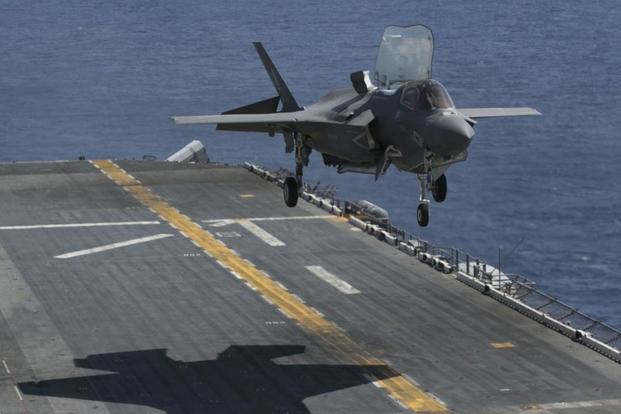When the Navy's F-35C Joint Strike Fighter embarks on its first carrier deployment in 2021, it's expected to take with it a pinpoint-accurate landing system that purports to make the terror of night approaches and high sea-state traps all but a thing of the past.
Raytheon announced this week that the Navy awarded a $234.6 million contract for a low-rate initial production of 23 of its Joint Precision Approach and Landing Systems, or JPALS -- enough to outfit every carrier and L-class amphibious assault ship with the technology. The contract also will include retrofitting three earlier systems that had been installed, a Raytheon executive said.
Delivering to the Navy will start late next year, and installation will begin shortly thereafter, retired Navy Rear Adm. C.J. Jaynes, Raytheon's JPALS technical executive, told Military.com this week. The work is expected to be completed by August 2023, according to a published contract announcement.
The system, which uses shipboard-relative GPS to guide planes in for landings and communicates with the aircraft from the deck of the carrier up to 200 nautical miles out, is accurate within 20 centimeters, or about 8 inches, Jaynes said.
"It hits the third wire every time," she said. "It's [reliable in] all-weather and all sea states, including Sea State 5 (waves of roughly 8 to 12 feet)."
For Navy pilots, catching the third of four wires on tailhook landings (or the second of three wires) has historically been a game of skill and precision that becomes orders of magnitude more difficult in the dark or in low-visibility weather conditions.
Marine Corps F-35B pilots, who use the aircraft's vertical-landing configuration to put it down on the smaller flight decks of amphibious ships, face the same problems. And those issues may actually be exacerbated by a number of F-35-specific issues pending resolution.
The custom-made, $400,000-per-unit helmet that F-35 pilots wear -- a piece of technology that allows them to "see through" the plane via a display for better situational awareness -- features symbology that emits a green glow, interfering with pilots' vision in low-light conditions. A video that emerged in 2017 showed an F-35 pilot landing "in a fog" on the amphibious assault ship America at night, his vision obscured by the helmet display. A recent Defense News report highlighted another issue with the helmet display at night that obscures the horizon.
JPALS, which has already deployed in an early-development version with F-35Bs aboard the amphibious assault ships Wasp and Essex, would decrease reliance on visibility for accurate landings. Another F-35C-installed tool, Delta Flight Path, will keep aircraft on a steady glide slope for carrier landings, reducing inputs and corrections required from pilots.
Early reports from the JPALS deployments with the Marines have been extremely positive, Jaynes said.
Related Content:
- Did F-35 Testing For Extreme Weather Conditions Fall Short?
- F-35 Pilot Killed in April Crash May have Ignored Instruments: Selva
"The pilots absolutely love it. It's been 100 percent accuracy, always available, they haven't had any issues at all," she said. "We know they have not had to abort any missions due to weather or due to sea state."
Raytheon is now pitching an expeditionary version of JPALS, easily transportable and designed to guide aircraft to safe landings on bare airfields. The whole system can fit in five transit cases, be transported by C-130 Hercules, and be assembled within 90 minutes, Raytheon says.
The Navy's future tanker drone, the MQ-25 Stingray, will also be JPALS-equipped; Jaynes said Raytheon is in talks with the service now about selling expeditionary JPALS for the MQ-25 program for shore-based tanker landings at locations like Norfolk, Virginia, or Point Mugu, California.
Meanwhile, she said, the Marine Corps is considering buying a single expeditionary JPALS system for testing in order to develop a concept of operations to employ it.
But "the closest customer outside of MQ-25 is actually the U.S. Air Force," Jaynes said.
"They'd be able to move their aircraft possibly every 24 to 48 hours and do island-hopping in the Pacific. We're going over to [United States Air Forces in Europe -- Air Forces Africa] in July to talk with them about the system," she said.
-- Hope Hodge Seck can be reached at hope.seck@military.com. Follow her on Twitter at @HopeSeck.














